
The Iron Duke class was a group of four dreadnought battleships built for the British Royal Navy before the First World War. The class comprised four ships: Iron Duke, Marlborough, Benbow, and Emperor of India. Launched from October 1912 to November 1913, this was the third class of Royal Navy super-dreadnoughts. The ships were essentially repeats of the King George V-class battleships; they retained the same ten 13.5 inch (34.3 cm) guns in five twin gun turrets on the centreline. However, the Iron Dukes had improved armour and a more powerful secondary armament of 6-inch weapons instead of the 4-inch mounted on the earlier ships.
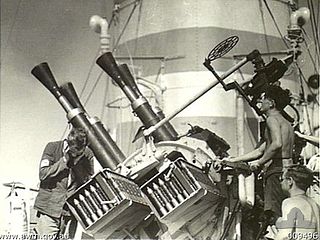
The 2-pounder gun, officially the QF 2-pounder and universally known as the pom-pom, was a 40 mm (1.6 in) British autocannon, used as an anti-aircraft gun by the Royal Navy. The name came from the sound that the original models make when firing. This QF 2-pounder was not the same gun as the Ordnance QF 2-pounder, used by the British Army as an anti-tank gun and a tank gun, although they both fired 2 lb (0.91 kg), 40 mm (1.6 in) projectiles.
This article explains terms used for the British Armed Forces' ordnance (weapons) and ammunition. The terms may have different meanings depending on its usage in another country's military.

The BL 6-inch gun Mark VII was a British naval gun dating from 1899, which was mounted on a heavy travelling carriage in 1915 for British Army service to become one of the main heavy field guns in the First World War, and also served as one of the main coast defence guns throughout the British Empire until the 1950s.
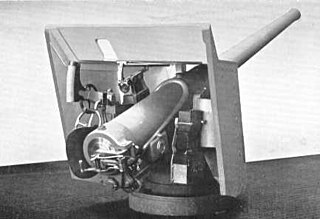
The QF 4.7-inch gun Mks I, II, III, and IV were a family of British quick-firing 4.724-inch (120 mm) naval and coast defence guns of the late 1880s and 1890s that served with the navies of various countries. They were also mounted on various wheeled carriages to provide the British Army with a long-range gun. They all had a barrel of 40 calibres length.

The QF 3-inch 20 cwt anti-aircraft gun became the standard anti-aircraft gun used in the home defence of the United Kingdom against German Zeppelins airships and bombers and on the Western Front in World War I. It was also common on British warships in World War I and submarines in World War II. 20 cwt referred to the weight of the barrel and breech, to differentiate it from other 3-inch guns. While other AA guns also had a bore of 3 inches (76 mm), the term 3-inch was only ever used to identify this gun in the World War I era, and hence this is what writers are usually referring to by 3-inch AA gun.

The Centurion-class battleships were a pair of pre-dreadnought battleships built for the Royal Navy in the 1890s. They were rated as second-class battleships because they were less heavily armed and armoured than the first-class battleships. They were designed for service abroad and were given higher speed and longer range to counter the armoured cruisers then being built as commerce raiders.
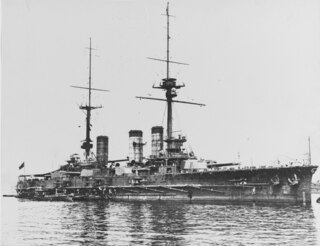
The Satsuma class was a pair of semi-dreadnought battleships built for the Imperial Japanese Navy (IJN) in the first decade of the 20th century. They were the first battleships to be built in Japan and marked a transitional stage between the pre-dreadnought and true dreadnought designs. They saw no combat during World War I, although Satsuma led a squadron that occupied several German colonies in the Pacific Ocean in 1914. Both ships were disarmed and expended as targets in 1922–1924 in accordance with the terms of the Washington Naval Treaty of 1922.

The QF 6-inch 40 calibre naval gun (Quick-Firing) was used by many United Kingdom-built warships around the end of the 19th century and the start of the 20th century. In British service it was known as the QF 6-inch Mk I, II, III guns. As the 15 cm/40 (6") 41st Year Type naval gun it was used for pre-dreadnought battleships, armoured cruisers and protected cruisers of the early Imperial Japanese Navy built in UK and European shipyards. It was also the heaviest gun ever carried by a pre-Cold War destroyer.
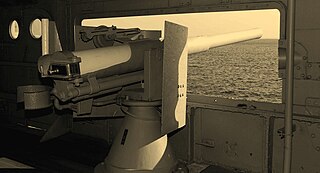
The QF 12-pounder 12-cwt gun (Quick-Firing) was a common, versatile 3-inch (76.2 mm) calibre naval gun introduced in 1894 and used until the middle of the 20th century. It was produced by Armstrong Whitworth, Elswick and used on Royal Navy warships, exported to allied countries, and used for land service. In British service "12-pounder" was the rounded value of the projectile weight, and "12 cwt (hundredweight)" was the weight of the barrel and breech, to differentiate it from other "12-pounder" guns.

The Ordnance QF Hotchkiss 6 pounder gun Mk I and Mk II or QF 6 pounder 8 cwt were a family of long-lived light 57 mm naval guns introduced in 1885 to defend against new, small and fast vessels such as torpedo boats and later submarines. There were many variants produced, often under license which ranged in length from 40 to 58 calibers, but 40 caliber was the most common version.

The QF 3-pounder Hotchkiss or in French use Canon Hotchkiss à tir rapide de 47 mm were a family of long-lived light 47 mm naval guns introduced in 1886 to defend against new, small and fast vessels such as torpedo boats and later submarines. There were many variants produced, often under license which ranged in length from 32 to 50 calibers but 40 caliber was the most common version. They were widely used by the navies of a number of nations and often used by both sides in a conflict. They were also used ashore as coastal defense guns and later as an anti-aircraft gun, whether on improvised or specialized HA/LA mounts.
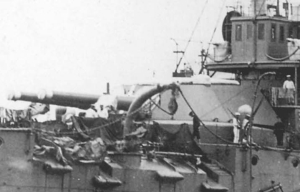
The Armstrong Whitworth 12-inch naval gun of 40 calibres length was designed by and manufactured mainly by Armstrong's ordnance branch, Elswick Ordnance Company. It was intended for the Royal Navy's Royal Sovereign-class battleships, but budgetary constraints delayed their introduction. The first units were instead supplied to Japan. As the Type 41 12-inch (305 mm) 40-calibre naval gun it was the standard main battery on several early United Kingdom-built pre-dreadnought battleships of the Imperial Japanese Navy.

The QF 12 pounder 18 cwt gun (Quick-Firing) was a 3-inch high-velocity naval gun used to equip larger British warships such as battleships for defence against torpedo boats. 18 cwt referred to the weight of gun and breech, to differentiate the gun from others that also fired the "12 pound" shell.

The Vickers 10 inch naval gun was used on battleships and armoured cruisers built during the first decade of the 20th century. They were used as the Type 41 10-inch /45-caliber aboard the British-built semi-dreadnought Katori-class battleships and the natively-built Satsuma-class battleships of the Imperial Japanese Navy.

The BL 5-inch guns Mk I – Mk V were early British 5-inch rifled breechloading naval guns after it switched from rifled muzzle-loaders in the late 1870s. They were originally designed to use the old gunpowder propellants. The 5-inch calibre was soon discontinued in favour of QF 4.7-inch.

The BL 6-inch Mark XII naval gun was a British 45 calibre naval gun which was mounted as primary armament on light cruisers and secondary armament on dreadnought battleships commissioned in the period 1914–1926, and remained in service on many warships until the end of World War II.

The Cannon 76/40 Model 1916 was a widely used naval gun on ships of the Royal Italian Navy during World War I and World War II. A very versatile weapon, it was used as primary, secondary and tertiary armament on a number of ship classes, while other ship classes had a shortened version of it, the Cannon 76/30 Model 1915. After being replaced aboard ships of the Royal Italian Navy it saw widespread use on land in a number of different roles such as coastal artillery, anti-aircraft gun and railroad gun during World War II.




















